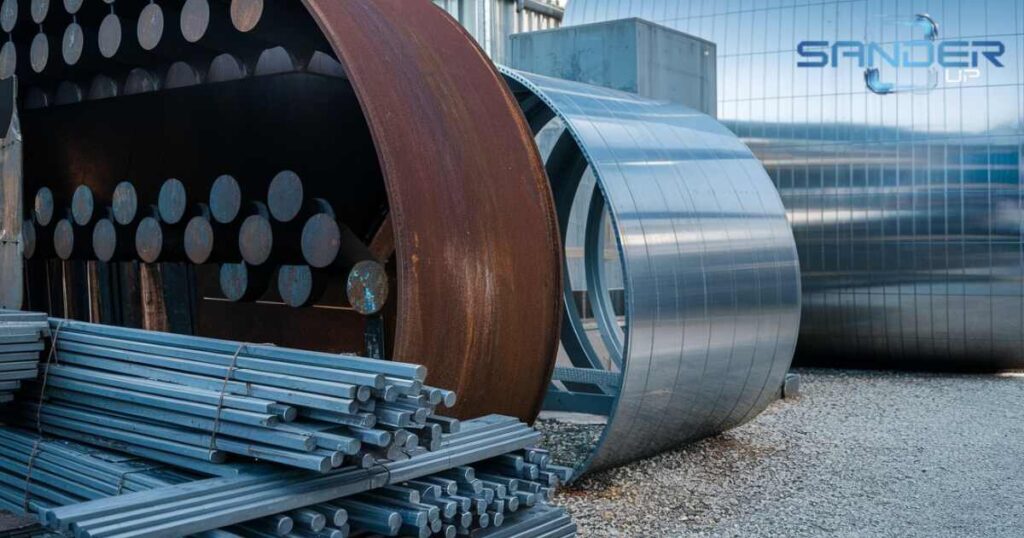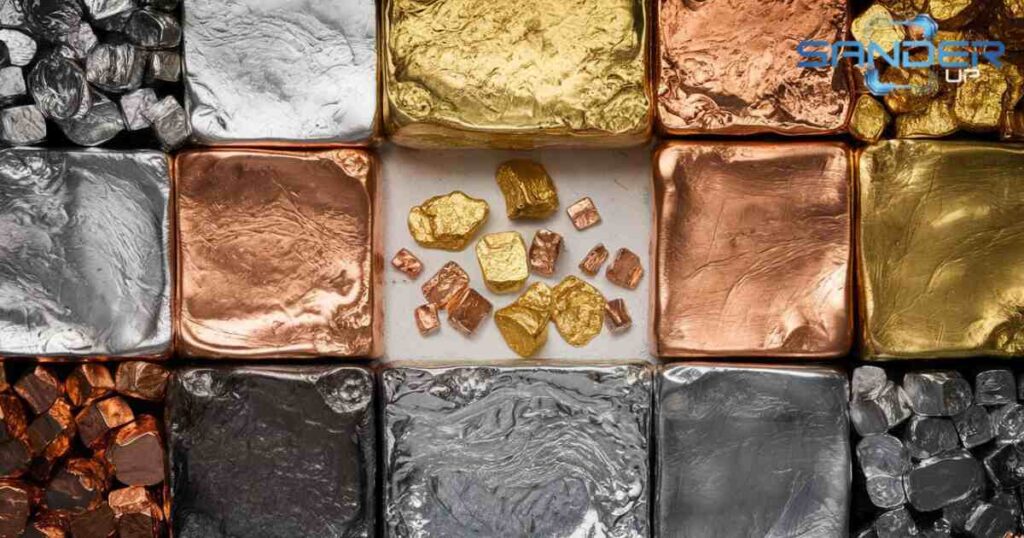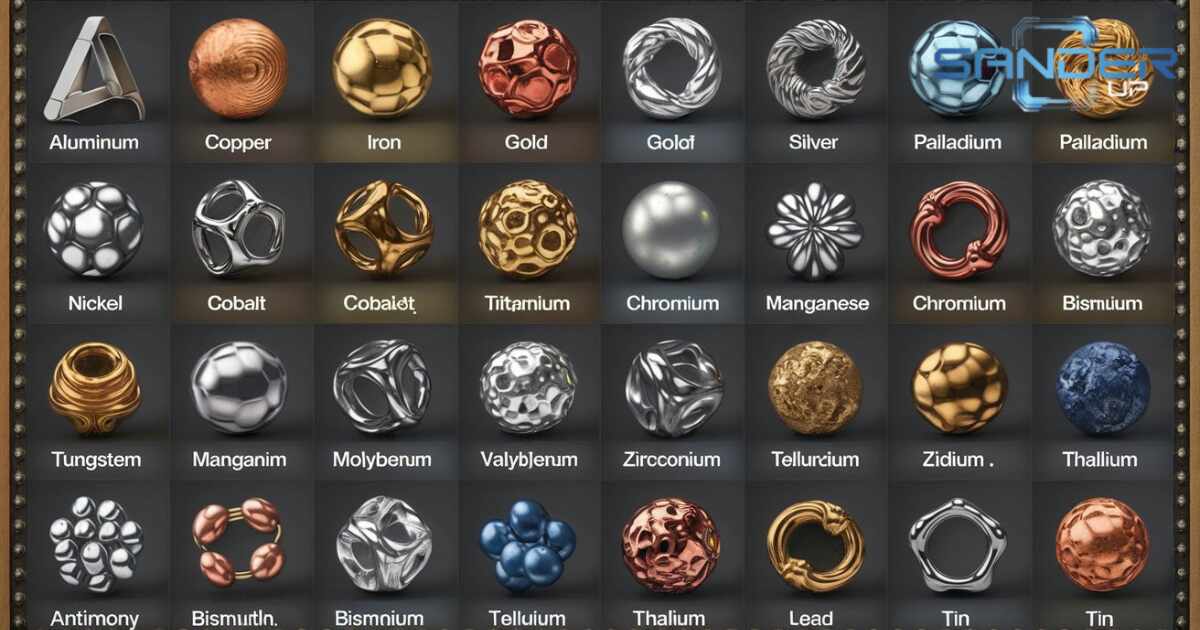Metals play a important role in our everyday lives, but do you know how many types there are? They are used in many things, from tools to cars. This article will guide you through the different types of metals and their unique applications. Understanding these materials can help you see the world in a new light. Whether you like fixing things or are just curious, there is something here for you.
Let’s explore the interesting world of metals together. Get ready to discover how these materials shape our daily experiences.
What Is Metal?

Metal is a natural material found in the earth’s crust. It is strong, shiny, and conducts heat and electricity well. Common metals like iron, copper, aluminum, and gold are used in many things, like buildings, machines, electronics, and jewelry.
Metals are durable and can be shaped without breaking. They can also be mixed with other elements to make stronger materials, called alloys. Because of these qualities, metal is important in industries like automotive, plumbing, and metalworking.
The Classification of Metals
1. Classification by Iron Content
- Ferrous Metals: These metals contain a significant amount of iron. Examples include steel and cast iron. They are known for their strength and are commonly used in construction and manufacturing.
- Non-Ferrous Metals: These metals contain little to no iron. Examples include aluminum, copper, and gold. They are often used in applications where corrosion resistance, lightweight properties, or specific electrical characteristics are required.
2. Classification by Atomic Structure
- Crystalline Metals: These metals have atoms arranged in a regular, repeating pattern. Examples include iron and gold. Their crystalline structure contributes to their strength and durability.
- Amorphous Metals: Also known as metallic glasses, these metals lack a long-range atomic order. They are often used in specialized applications where unique properties like high strength and elasticity are needed.
Types of Metal
There are several types of metal, each with unique properties and uses. Here are some common categories:
1. Ferrous Metals (Contain Iron)
- Steel: An alloy of iron and carbon, widely used in construction, tools, and machinery.
- Cast Iron: Iron alloy with a high carbon content, used in heavy-duty items like pipes, machinery, and automotive parts.
- Stainless Steel: Steel alloy with chromium, known for corrosion resistance, used in cutlery, kitchen equipment, and medical instruments.
2. Non-Ferrous Metals (Do not contain Iron)
- Aluminum: Lightweight and corrosion-resistant, commonly used in packaging, aircraft, and automotive parts.
- Copper: Excellent conductor of electricity and heat, used in wiring, plumbing, and roofing.
- Brass: An alloy of copper and zinc, used in musical instruments, fittings, and decorative items.
- Bronze: An alloy of copper and tin, used in bearings, sculptures, and marine equipment.
- Zinc: Primarily used for galvanizing steel to prevent rusting and in die-casting alloys.
3. Precious Metals (Valuable and Rare)
- Gold: Used in jewelry, electronics, and currency.
- Silver: Used in jewelry, electronics, and photography.
- Platinum: Used in catalytic converters, jewelry, and medical equipment.
4. Alloys (Combination of Two or More Metals)
- Titanium Alloys: Strong and lightweight, used in aerospace, medical implants, and sporting goods.
- Nickel Alloys: Used in high temperature and corrosion-resistant applications like gas turbines and chemical plants.
Each type of metal has specific properties such as strength, malleability, conductivity, and resistance to corrosion, which dictate its usage in various industries.
Names of Metals
Here is a list of metal names:
- Aluminum
- Antimony
- Barium
- Beryllium
- Bismuth
- Boron
- Brass (an alloy of copper and zinc)
- Bronze (an alloy of copper and tin)
- Cadmium
- Calcium
- Cast Iron
- Chromium
- Cobalt
- Copper
- Gold
- Iron
- Lead
- Lithium
- Magnesium
- Manganese
- Molybdenum
- Nickel
- Palladium
- Platinum
- Rhodium
- Ruthenium
- Silver
- Sodium
- Tantalum
- Titanium
- Tungsten
- Uranium
- Vanadium
- Zinc
- Zirconium
This list covers a range of metals with different properties and applications, from those used in everyday items to specialized industrial uses.
Kinds of Metal

Here is an easy to understand explanation of each metal:
1. Aluminum
Aluminum is a light and rust-resistant metal used in everyday items like soda cans, airplanes, and kitchen foil. Its low density and strength make it ideal for reducing weight in transportation. It is also highly recyclable, which helps minimize environmental impact. Aluminum’s versatility makes it a popular choice in many industries.
2. Antimony
Antimony is a brittle metal used in batteries, flame retardants, and some electronics. It helps make materials more resistant to fire and wear. It’s also used in small quantities to improve the performance of other materials. Its unique properties make it useful in a variety of applications.
3. Barium
Barium is a heavy metal used as a contrast agent in X-ray imaging to help doctors see internal structures. It’s also used in fireworks to produce green colors and in the manufacturing of certain types of glass. Its role in medical imaging and pyrotechnics highlights its diverse uses. Barium’s properties make it valuable in both health and entertainment industries.
4. Beryllium
Beryllium is a lightweight and strong metal used in high-tech parts like X-ray machines and spacecraft. Its strength-to-weight ratio makes it perfect for precision instruments and aerospace components. Beryllium’s high thermal stability and durability make it an essential material for specialized applications. It’s valuable for its unique combination of properties.
5. Bismuth
Bismuth is a metal with a low melting point, often found in medicines like Pepto-Bismol and some cosmetics. It has a pinkish hue and is one of the least toxic heavy metals. Its low thermal conductivity and non-toxicity make it useful in various products. Bismuth’s unique characteristics make it suitable for both medical and consumer applications.
6. Boron
Boron is a metal used to strengthen glass and ceramics, making them more durable. It’s also found in some fertilizers to promote healthy plant growth. Its ability to enhance materials and support agriculture highlights its importance in different fields. Boron’s versatility makes it a valuable element in both industrial and agricultural uses.
7. Brass
Brass is an alloy made from copper and zinc, known for its durability and corrosion resistance. It’s commonly used in plumbing fixtures, musical instruments, and decorative items. The alloy’s golden appearance and strength make it ideal for both functional and aesthetic applications. Brass’s combination of properties makes it a popular choice in various industries.
8. Bronze
Bronze is an alloy of copper and tin, valued for its hardness and resistance to corrosion. Historically used for tools and statues, it remains important for making bearings and marine hardware. Its strength and durability make it suitable for demanding applications. Bronze’s historical and practical significance underscores its continued relevance.
9. Cadmium
Cadmium is a soft, malleable metal used in batteries and coatings, but it is toxic and must be handled with care. It helps improve battery performance and provides protective coatings for other metals. Due to its toxicity, its use is now highly regulated. Cadmium’s role in energy storage and protection highlights its importance despite safety concerns.
10. Calcium
Calcium is a metal essential for bone health and used in making steel and cement. It’s also found in fertilizers to improve soil quality. Calcium’s importance extends from health to construction and agriculture. Its wide range of uses makes it a vital element in many industries.
11. Cast Iron
Cast iron is a type of iron that is strong but can be brittle. It’s commonly used in making pipes, engine blocks, and cookware due to its durability. The metal’s ability to hold up under stress makes it ideal for heavy-duty applications. Cast iron’s strength and versatility highlight its usefulness in various sectors.
12. Chromium
Chromium is a metal known for making steel hard and shiny. It’s used in coatings to protect other metals from rust and in making stainless steel. Its ability to enhance durability and appearance makes it valuable in both industrial and decorative applications. Chromium’s role in improving steel’s properties underscores its importance.
13. Cobalt
Cobalt is a metal used in batteries, magnets, and high-performance alloys. It’s also used to create blue pigments for ceramics and dyes. Cobalt’s ability to improve strength and color makes it useful in both technological and artistic applications. Its diverse uses highlight its importance in modern materials and processes.
14. Copper
Copper is a reddish metal known for its excellent electrical conductivity. It’s widely used in wiring, plumbing, and roofing materials. Its ability to conduct electricity efficiently makes it essential for many electrical applications. Copper’s versatility and conductivity make it a fundamental material in various industries.
15. Gold
Gold is a valuable, yellow metal used in jewelry, coins, and as an investment. Its resistance to corrosion and tarnish makes it ideal for high-end applications and electronics. Gold’s rarity and unique properties contribute to its high value and widespread use. Its significance spans from luxury items to essential technology components.
16. Iron
Iron is a strong metal that forms the basis for steel production. It’s used in construction, tools, and machinery due to its strength and durability. Iron’s role in building infrastructure and manufacturing highlights its importance in everyday life. Its versatility and robustness make it a fundamental material in many industries.
17. Lead
Lead is a heavy, soft metal once used in pipes and paints but now mostly replaced due to its toxicity. It is still used in batteries and radiation shielding due to its dense and protective qualities. Lead’s historical uses and current applications in specific areas highlight its unique properties and the need for careful handling.
18. Lithium
Lithium is a light metal used in rechargeable batteries for electronics like smartphones and laptops. Its high energy density and low weight make it ideal for portable power sources. Lithium’s role in modern technology underscores its importance in energy storage. Its unique properties make it essential for powering many devices.
19. Magnesium
Magnesium is a light metal used in automotive and aerospace applications for its strength and low weight. It also burns with a bright light, making it useful in fireworks and flares. Magnesium’s strength-to-weight ratio and brightness contribute to its value in both industrial and recreational uses. Its properties make it suitable for a variety of applications.
20. Manganese
Manganese is a metal used to strengthen steel and in battery production. It also plays a role in making alloys and is an essential trace element for health. Manganese’s ability to improve steel’s properties and support human health highlights its importance. Its versatility makes it valuable in different fields.
21. Molybdenum
Molybdenum is a metal known for its high melting point and strength. It is used in steel alloys to enhance their heat resistance and durability. Its properties make it ideal for high-temperature applications and industrial uses. Molybdenum’s role in strengthening materials highlights its significance in manufacturing.
22. Nickel
Nickel is a metal used to make stainless steel and in coatings to prevent rust. It’s also found in coins and electronics due to its resistance to corrosion. Nickel’s ability to enhance the durability of materials makes it valuable in various applications. Its properties contribute to its widespread use in industrial and consumer products.
23. Palladium
Palladium is a precious metal used in jewelry and automotive exhaust systems. It helps reduce harmful emissions and is valued for its shine and durability. Palladium’s role in both luxury and environmental applications underscores its versatility. Its properties make it important in various high-tech and consumer products.
24. Platinum
Platinum is a dense, precious metal used in jewelry and catalytic converters. Its resistance to corrosion and high value make it ideal for high-end and industrial uses. Platinum’s durability and catalytic properties contribute to its importance in various applications. Its role in both luxury and technology highlights its significance.
25. Rhodium
Rhodium is a rare metal used in catalytic converters to reduce vehicle emissions and as a shiny plating for jewelry. Its reflective properties and corrosion resistance make it valuable in both industrial and decorative uses. Rhodium’s role in improving environmental performance and enhancing aesthetics underscores its importance.
26. Ruthenium
Ruthenium is a metal used in electronics and as a catalyst in chemical reactions. It improves the performance of high-tech devices and helps facilitate important chemical processes. Ruthenium’s role in both technology and industry highlights its versatility. Its properties make it useful in a range of specialized applications.
27. Silver
Silver is a shiny metal used in jewelry, coins, and electronics. It conducts electricity well and has antibacterial properties, making it useful in various applications. Silver’s beauty and functionality make it a popular choice in both luxury and technology sectors. Its properties enhance its value and usability.
28. Sodium
Sodium is a highly reactive metal used in streetlights and glassmaking. It also plays a role in producing various chemicals and materials. Sodium’s reactivity and versatility make it essential in many industrial processes. Its properties contribute to its wide range of applications.
29. Tantalum
Tantalum is a rare metal known for its resistance to corrosion and high temperatures. It is used in electronics and medical implants due to its durability. Tantalum’s ability to withstand harsh conditions makes it valuable in both high-tech and medical fields. Its unique properties enhance its importance in specialized applications.
30. Titanium
Titanium is a strong, lightweight metal used in aerospace, medical implants, and high-performance alloys. Its resistance to corrosion and strength make it ideal for demanding uses. Titanium’s combination of durability and lightness makes it valuable in various industries. Its properties contribute to its widespread application.
31. Tungsten
Tungsten is a metal with an extremely high melting point, making it useful for lightbulb filaments and cutting tools. Its strength and density make it suitable for high-stress applications. Tungsten’s ability to withstand high temperatures and its robustness highlight its importance in manufacturing and industry.
32. Uranium
Uranium is a heavy, radioactive metal used as fuel in nuclear reactors. Its ability to produce energy through nuclear fission makes it crucial for power generation. Uranium must be handled with care due to its radioactive nature. Its role in energy production highlights its significance despite safety concerns.
33. Vanadium
Vanadium is a metal used to strengthen steel and in energy storage technologies. It enhances the durability of steel alloys and is also found in some batteries. Vanadium’s ability to improve materials and support energy solutions underscores its importance. Its properties make it valuable in both construction and technology.
34. Zinc
Zinc is a metal used to protect steel from rust and in batteries. It is also an essential nutrient for human health. Zinc’s ability to prevent corrosion and its role in health highlight its importance. Its versatility makes it useful in various industrial and biological applications.
35. Zirconium
Zirconium is a metal known for its resistance to heat and corrosion. It is used in nuclear reactors and to create strong materials for industrial applications. Zirconium’s durability and stability make it valuable in high-temperature and high-stress environments. Its properties enhance its usefulness in specialized fields.
Periodic Table Of Elements Metals
Here Is a periodic table of metals, highlighting their atomic numbers and atomic masses:
| Element | Symbol | Atomic Number | Atomic Mass |
| Alkali Metals | |||
| Lithium | Li | 3 | 6.94 |
| Sodium | Na | 11 | 22.990 |
| Potassium | K | 19 | 39.098 |
| Rubidium | Rb | 37 | 85.468 |
| Cesium | Cs | 55 | 132.91 |
| Francium | Fr | 87 | 223 |
| Alkaline Earth Metals | |||
| Beryllium | Be | 4 | 9.0122 |
| Magnesium | Mg | 12 | 24.305 |
| Calcium | Ca | 20 | 40.078 |
| Strontium | Sr | 38 | 87.62 |
| Barium | Ba | 56 | 137.33 |
| Radium | Ra | 88 | 226 |
| Transition Metals | |||
| Scandium | Sc | 21 | 44.956 |
| Titanium | Ti | 22 | 47.867 |
| Vanadium | V | 23 | 50.942 |
| Chromium | Cr | 24 | 51.996 |
| Manganese | Mn | 25 | 54.938 |
| Iron | Fe | 26 | 55.845 |
| Cobalt | Co | 27 | 58.933 |
| Nickel | Ni | 28 | 58.933 |
| Copper | Cu | 29 | 63.546 |
| Zinc | Zn | 30 | 65.38 |
| Yttrium | Y | 39 | 88.906 |
| Zirconium | Zr | 40 | 91.224 |
| Niobium | Nb | 41 | 92.906 |
| Molybdenum | Mo | 42 | 95.95 |
| Technetium | Tc | 43 | 98 |
| Ruthenium | Ru | 44 | 101.07 |
| Rhodium | Rh | 45 | 102.91 |
| Palladium | Pd | 46 | 106.42 |
| Silver | Ag | 47 | 107.87 |
| Cadmium | Cd | 48 | 112.41 |
| Hafnium | Hf | 72 | 178.49 |
| Tantalum | Ta | 73 | 180.95 |
| Tungsten | W | 74 | 183.84 |
| Rhenium | Re | 75 | 186.21 |
| Osmium | Os | 76 | 190.23 |
| Iridium | Ir | 77 | 192.22 |
| Platinum | Pt | 78 | 195.08 |
| Gold | Au | 79 | 196.97 |
| Mercury | Hg | 80 | 200.59 |
| Post-Transition Metals | |||
| Aluminum | Al | 13 | 26.982 |
| Gallium | Ga | 31 | 69.723 |
| Indium | In | 49 | 114.82 |
| Tin | Sn | 50 | 118.71 |
| Lead | Pb | 82 | 207.2 |
| Lanthanides | |||
| Lanthanum | La | 57 | 138.91 |
| Cerium | Ce | 58 | 140.12 |
| Praseodymium | Pr | 59 | 140.91 |
| Neodymium | Nd | 60 | 144.24 |
| Samarium | Sm | 62 | 150.36 |
| Europium | Eu | 63 | 151.96 |
| Gadolinium | Gd | 64 | 157.25 |
| Terbium | Tb | 65 | 158.93 |
| Dysprosium | Dy | 66 | 162.50 |
| Holmium | Ho | 67 | 164.93 |
| Erbium | Er | 68 | 167.26 |
| Thulium | Tm | 69 | 168.93 |
| Ytterbium | Yb | 70 | 173.04 |
| Lutetium | Lu | 71 | 174.97 |
| Actinides | |||
| Actinium | Ac | 89 | 227 |
| Thorium | Th | 90 | 232.04 |
| Protactinium | Pa | 91 | 231.04 |
| Uranium | U | 92 | 238.03 |
| Neptunium | Np | 93 | 237 |
| Plutonium | Pu | 94 | 244 |
| Americium | Am | 95 | 243 |
| Curium | Cm | 96 | 247 |
| Berkelium | Bk | 97 | 247 |
| Californium | Cf | 98 | 251 |
| Einsteinium | Es | 99 | 252 |
| Fermium | Fm | 100 | 257 |
| Mendelevium | Md | 101 | 258 |
| Nobelium | No | 102 | 259 |
| Lawrencium | Lr | 103 | 262 |
This table covers metals from various categories, including alkali metals, alkaline earth metals, transition metals, post-transition metals, lanthanides, and actinides.
Metallic Element
A metallic element is a type of substance found on the periodic table with distinct properties. Metals are excellent conductors of electricity and heat due to their free-moving electrons.
They also possess malleability, meaning they can be hammered into thin sheets, and ductility, allowing them to be stretched into wires without breaking. Metals have a shiny, reflective surface because they can effectively reflect light.
Chemically, metals tend to lose electrons and form positive ions, such as when sodium reacts with water to produce sodium hydroxide and hydrogen gas. Common examples include iron, used in construction and tools; copper, used in electrical wiring; and gold, valued for jewelry and electronics. These characteristics make metals essential in various applications, from building materials to electronic devices.
What type of Lubricant is used for Machining Metal?
For machining metal, various types of lubricants are used to reduce friction, dissipate heat, and improve the cutting process. The most common types include:
- Cutting Fluids: These are specialized liquids used during metal cutting processes. They can be categorized into:
- Coolants: These fluids primarily cool the cutting tool and workpiece, reducing heat and preventing thermal damage. Examples include water-soluble oils and synthetic coolants.
- Lubricants: These fluids reduce friction between the cutting tool and the workpiece. They help in prolonging tool life and improving the surface finish. Examples include neat oils and semi-synthetic fluids.
- Neat Oils: These are pure oils used for lubrication without any dilution. They are often used in high-speed machining operations. Examples include mineral oils and ester-based oils.
- Emulsions: These are mixtures of oil and water that provide both cooling and lubrication. They are commonly used in various machining processes and offer good heat dissipation while reducing friction.
- Synthetic Fluids: These fluids are engineered to provide high performance in terms of cooling and lubrication without the use of petroleum-based products. They are often used in high-precision machining applications.
- Aerosol Lubricants: These are spray lubricants used for light-duty machining tasks. They offer easy application and are useful for small-scale or maintenance work.
- Greases: For certain machining applications where liquid lubricants are impractical, greases might be used. They provide long-lasting lubrication and can be used in applications where frequent reapplication is not feasible.
Name a type of Metal
Aluminum is a commonly used metal. It is lightweight, resistant to corrosion, and has good thermal and electrical conductivity. Aluminum is used in industries such as aerospace, automotive, and construction, as well as for packaging materials like aluminum foil.
What type of Metal is Aluminum?
Aluminum is a non-ferrous metal, meaning it does not contain iron and is not magnetic. It is a lightweight, silvery-white metal known for its low density, high strength-to-weight ratio, and excellent corrosion resistance. Aluminum is also highly conductive, both electrically and thermally, and is easily malleable, making it suitable for a wide range of applications.
It belongs to the group of light metals and is typically alloyed with other metals like copper, magnesium, or silicon to enhance its strength and durability for specific uses, such as in construction, automotive, aerospace, and packaging industries.
What type of Metal is Potassium?
Potassium is an alkali metal, which is part of Group 1 on the periodic table. It is a soft, silvery-white metal that is highly reactive, especially with water, where it reacts vigorously to produce heat, hydrogen gas, and potassium hydroxide. Due to its high reactivity, potassium is not found in its pure form in nature but is usually found in mineral compounds.
Potassium is essential for biological processes, particularly in plants and animals, where it plays a crucial role in cell function, nerve transmission, and muscle contraction. However, because of its reactivity, it must be handled with care in a controlled environment.
FAQ’s
What are the main types of metals?
The main types of metals are ferrous, non-ferrous, and precious metals. Ferrous metals contain iron, like steel and cast iron. Non-ferrous metals don’t have iron, such as aluminum, copper, and brass. Precious metals are rare and valuable, including gold, silver, and platinum.
What are the 5 basic metals?
The five basic metals are iron, aluminum, copper, gold, and silver.
Are there 92 metals?
There are 92 naturally occurring elements, but not all of them are metals. Around 70 of these elements are metals.
What are 4 pure metals?
Four pure metals are gold, silver, copper, and aluminum.
Is diamond a metal?
No, diamond is not a metal; it is a form of carbon.
What is the strongest metal?
The strongest metal in terms of tensile strength is tungsten.
What are Precious Metals and Precious Metals Alloys?
Precious Metals are rare and valuable metals, such as gold, silver, and platinum.
Precious Metal Alloys are mixtures of these metals with other elements to enhance properties, like durability or color (e.g., white gold, platinum alloys).
What are 4 types of non metals?
Four types of non-metals are oxygen, nitrogen, carbon, and sulfur.
Is carbon a metal?
No, carbon is not a metal. it is a non-metal.
Conclusion
Metals are categorized into ferrous (containing iron) and non-ferrous (without iron), with alloys combining metals to enhance properties. Specialty metals like precious and rare metals have unique uses due to their specific characteristics.
Different casting methods, such as sand and die casting, shape metals for various applications, each offering distinct benefits based on strength, weight, and corrosion resistance.











